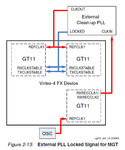kaiserschmarren87
Member level 4
Hi,
I have a DRP design for Virtex-4 transceiver. I would like to know is it possible to have a single .bit file and use it for several different bit rates (i.e. 3.125 Gbps, 4.8 Gbps, 6.4 Gbps etc.) ?
How to modify DRP to handle this ? Since I use rocketIO wizard generated .vhd files for transceiver configuration, I have enabled DRP in the wizard. So if I generate rocketIO wizard for 6.4 Gbps and then enable DRP in it, what changes in DRP module or which parameter in it needs to be changed so that I can use only one .bit file for several bit rates as mentioned above.
Thank you.
I have a DRP design for Virtex-4 transceiver. I would like to know is it possible to have a single .bit file and use it for several different bit rates (i.e. 3.125 Gbps, 4.8 Gbps, 6.4 Gbps etc.) ?
How to modify DRP to handle this ? Since I use rocketIO wizard generated .vhd files for transceiver configuration, I have enabled DRP in the wizard. So if I generate rocketIO wizard for 6.4 Gbps and then enable DRP in it, what changes in DRP module or which parameter in it needs to be changed so that I can use only one .bit file for several bit rates as mentioned above.
Thank you.
Last edited:


